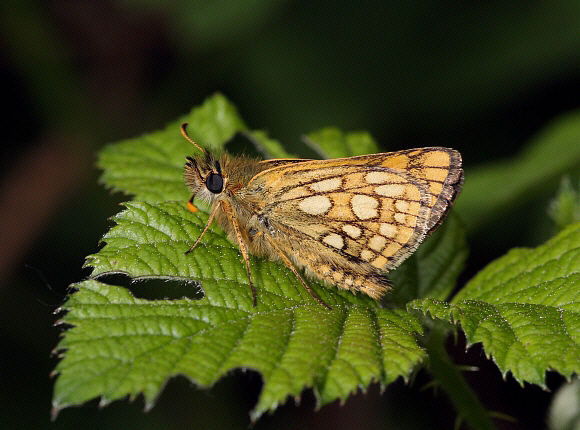
Introduction
There are 15 Carterocephalus species. The genus is centred on China, but 3 species reach Europe including palaemon.
Older literature treats Carterocephalus as a member of the Hesperiinae, but the genus is currently placed in the Heteropterinae due to differences in the structure of the antennae, palpi and venation. There are only a few members of the Heteropterinae which occur in the northern hemisphere. In South America there are many related species in the genus Dalla – largely montane species from the Andes; and another similar genus, Metisella, occurs in the tropics of Africa.
All Carterocephalus species are dark brown with yellow or cream markings. The pattern is repeated on the underside, but in muted colours.
In Britain palaemon is known as the Chequered Skipper, but in the USA and Canada it is usually referred to as the Arctic Skipper or Arctic Skipperling. The butterfly is found across most of Europe and temperate Asia to Japan. It is the only Carterocephalus species found on North America where it occurs in northern California, southern Alaska and across most of Canada.
Habitats
This species is found in grassy glades and clearings in coniferous or deciduous temperate and sub-arctic forest, at elevations between sea level and about 1500m.
Lifecycle
The shiny white spherical eggs are laid singly on the underside of grass blades. Oviposition occurs primarily on grasses growing in dappled sunlight beneath bog myrtle bushes. They are usually laid on Molinea caerulea, but occasionally on Brachypodium, Calamagrostis or Bromus (Poaceae).
The larva makes its first meal of the eggshell. It later constructs a shelter made by rolling a blade of grass into a tube, held together with strands of silk. As it grows, it moves to other grass blades and constructs larger tubes. It feeds diurnally, eating little notches out of the grass blade above and below where it rests. Like other grass-feeding skippers, the larva is equipped with a pair of prongs at the tail end, which it uses to flick away its droppings. This helps to prevent the grass shelter from becoming fouled, and also removes evidence of the larva’s presence which might otherwise attract parasitoids or predators.
When the larva is fully grown in late September it constructs a silk tent amongst the grass blades, where it hibernates until April. The mature larva is pale green, but in autumn the colour gradually changes to pale straw, matching the surroundings. Prior to pupation in May the larva constructs yet another shelter, made from dead grasses and silk. The long thin pupa is formed within the shelter. It is pale ochreous, with dark lines along the back and sides. The pupal stage lasts about 2 weeks.
Adult behaviour
On sunny mornings males establish perches on bushes or saplings. They use these vantage points to survey passing females, and defend their territories vigorously against all passing insects. Other male Chequered Skippers are promptly ousted from the vicinity. When a female is intercepted she is chased until she settles, whereupon copulation takes place immediately. The pair remain joined for about an hour, during which time they sit with wings held erect, on low foliage.
Both sexes spend long periods basking on the terminal leaves of shoots of bog myrtle, birch, and other small trees or shrubs. Unlike Hesperiine skippers, but like the Pyrginae, they usually bask with their wings spread flat, usually with the forewings draped slightly backwards.
They nectar, with wings closed, at a wide variety of herbaceous plants including dandelion, bugle, lousewort, bluebells and orchids. Males also imbibe from wet soil at the edges of puddles.
In dull dry weather and overnight, the butterflies roost on the terminal leaves of bog myrtle bushes, or sometimes on bracken fronds or clumps of heather. In wet weather they hide deep within grass tussocks.
